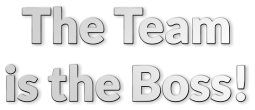
NVC-plus Matrix
for Projects and Companys
In
the
conventional
functional
structures
of
a
company,
employees
are
usually
fixed
to
their
fixed
positions,
functions
and
roles.
In
traditional
matrix
organizations,
employees
can
already
switch
between
administrative
teams
(e.g.
workshop,
office,
sales)
and
project
teams
(project
1,
project
2,
project
3).
This
is
similar
to
what
we
model
at
NVC-plus
with
our
stable
home
teams
and
short-term
action-based
teams.
In
traditional
companies
and
teams,
there
is
usually
a
central
controlling
position,
often
represented
by
a
boss.
Agile
teams
try
to
go
one
step
further,
but
they
are
still
functional
teams.
At
NVC-plus,
we
do
not
have
a
central
controlling
position.
The
project
or
even
the
entire
company
is
self-organized.
Instead
of
a
central
management,
there
are
three
separate
areas
of
control,
which
could
be
traced
back
to
Rudolf
Steiner's
social
threefold
structure.
Steiner
had
spoken
at
that
time
1.)
of
law,
2.)
of
spiritual
science
and
3.)
of
economy.
We
have
translated
this
as
follows:
Law
does
not
mean,
in
its
essence,
jurisdiction,
but
the
right
or
good
order
of
togetherness,
that
is,
what
is
actually
the
culture
of
togetherness.
The
humanities
bring
innovations
and
developments
into
play.
Through
it,
the
so
important
creativity
comes
into
play
as
an
influx
of
new,
expressing
vitality.
And
the
economy,
that
is
the
active
implementation
of
productive
projects.
This
gives
us
our
threefold
division
into
the
collaboration,
the
innovations
and
the
production
of
a
company.
On
the
other
hand,
the
goals,
ways
and
implementation
of
people
also
come
into
play,
which
can
be
described
as
their
visions,
strategies
and
tactical
executions.
Thus,
the
following
matrix
results from the liveliness of the people and the structures that manifest themselves in this way:



Video: Die NVC-plus Matrix
A
self-directing
company
does
not
come
out
of
a
hat,
it
is
consciously
and
actively
formed
by
the
people
involved.
It
needs
a
sufficient
number
of
committed
and
open
people
who
trust
each
other
enough
to
start
experimenting
in
this
direction.
The
rest
then
first
arises
at
a
certain
level
and
this
only
needs
to
be
appropriate
or
at
least
sufficient
for
the
project.
In
the
course
of
practice
this
level
will
automatically
rise
step
by
step,
as
people
arrive
more
and
more
holistically
in
a
living
structure.
It
is
also
first
necessary
to
get
the
old
dominant
and
functional
organizational
structures
out
of
one's
head.
This
is
easier
than
one
might
think.
Because
you
not
only
learn
NVC-plus,
you
also
remember
it,
because
it
carries
the
structures
of
natural togetherness.

The
control
area
:
Three
control
centers
and
three
ways
of
working
on
them
-
this
results
in
9
colored fields to which all team members can freely contribute at any time.
The
manifestation
area
:
The
lower
three
gray
manifestation
fields
show
the
areas
of
practical
work and results.
One
can
also
simply
apply
the
NVC-plus
matrix
as
a
diagnostic
and
prognostic
tool
if
one
does
not
want
to
use
it
for
self-control.
In
a
spreadsheet
program,
the
NVC-plus
matrix
can
be
well
presented
as
a
worksheet.
You
can
fill
it
out
together.
For
virtual
conferences,
Google
spreadsheets
might
be
suitable.
There
is
an
App
in
the
App-Stores
for
mobile
devices.
In
the
download
we
created,
we
also
included
more
detail
worksheets
for
each area. Each team can play their own creativity and use the tools they are used to.
The
nine
control
fields
and
the
three
manifestation
fields
make
the
collaboration
of
a
team
self-organizing.
The
team
can
identify
its
blind
spots
and
initiate
the
appropriate
planning
steps
there.
Not
everything
that
later
manifests
itself
through
productive
work
is
also
produced
directly
by
the
team.
For
example,
the
tractor
compacts
the
soil
with
its
weight,
but
the
tractor
manufacturer
does
not
directly
cause
this
with
its
production.
The
compaction
is
manifested
by
driving
the
tractor
on
the
field.
The
manufacturer
can
look
at
this
and
try
to
develop
counter
concepts.
A
team
can
also
include
what
it
has
not
actively
produced
so
that
it
can
intervene
where
it
does
not
like
the
passive
effects
of
its
actions.
In
NVC-plus
teams,
we
focus
on
future-oriented
responsibility
rather
than
cultivating
past-oriented
ideas
of
blame,
because
the
future
can
be
changed.
The
three-way
split
means
that
the
central
leadership
position
is
missing.
This
does
not
mean
that
one
person
does
not
set
the
tone,
as
long
as
that
is
wanted
and
accepted.
But
there
is
no
central
position
for
that
and
thus
that
person
will
behave
similarly
to
everyone
else:
All
participants
switch
between
the
fields
according
to
their
inspiration,
impulse
and
perceived
meaningfulness.
Through
these
position
changes
and
the
free
access
of
all
people
to
the
vision,
the
strategy
and
the
tactical
approach,
the
structure
comes
alive.
With
NVC-plus's
four-step
circle,
chaos
is
avoided
and
people's
aspirations
synchronize
into
shared
visions,
strategies
and
tactics.
Since
each
person
has
his
or
her
own
strengths,
weaknesses
and
preferences,
these
shifts
are
suitable
not
only
for
self-
organizing
potential
where
it
is
needed,
but
also
for
learning
from
each
other,
supporting
each
other
and
getting
to
know
each
other
better.
By
introducing
the
NVC-plus
matrix
step
by
step
in
the
context
of
smaller
projects, the necessary understanding and awareness can easily be formed.
For
a
good
project
start,
the
NVC-plus
matrix
will
first
be
filled
in
as
a
project
matrix.
This
does
not
require
everyone
to
be
involved,
because
one
can
always
intervene
later
in
a
changing
way.
When
it
comes
to
an
inspiring
start
vision,
a
good
initial
strategy
or
optimal
tactics,
it
helps
to
sit
down
with
the
right
people
in
each
case
and
then
make
the
preliminary
results
available
to
everyone.
This
reduces
the
amount
of
communication
required
and
makes
teamwork
more
effective.
If
you
also
apply
the
four-step
circle,
it
works
even
better.
By
the
way,
the
NVC-plus
matrix
is
always
provisional
as
a
control
matrix,
because
otherwise
the
work would no longer be self-organized and interactively intelligent.
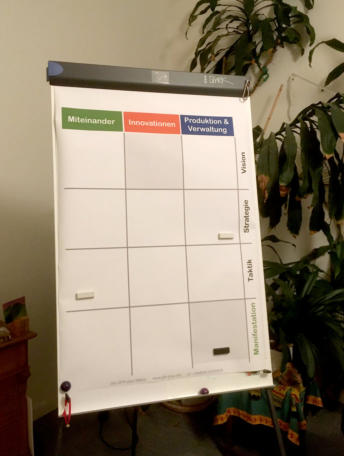
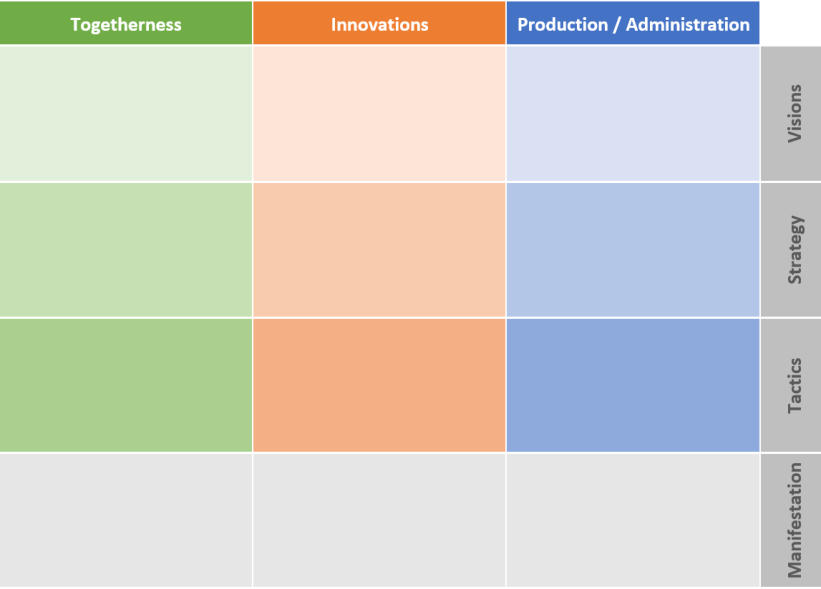
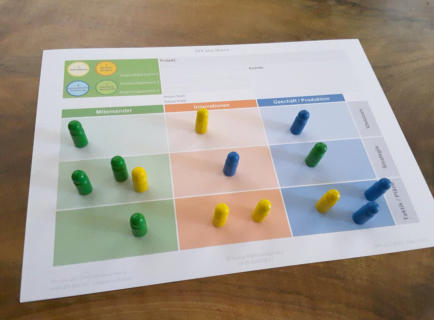
Organising projects with self-organised teams


In
the
conventional
functional
structures
of
a
company,
employees
are
usually
fixed
to
their
fixed
positions,
functions
and
roles.
In
traditional
matrix
organizations,
employees
can
already
switch
between
administrative
teams
(e.g.
workshop,
office,
sales)
and
project
teams
(project
1,
project
2,
project
3).
This
is
similar
to
what
we
model
at
NVC-plus
with
our
stable
home
teams
and
short-term
action-based
teams.
In
traditional
companies
and
teams,
there
is
usually
a
central
controlling
position,
often
represented
by
a
boss.
Agile
teams
try
to
go
one
step
further,
but
they
are
still
functional
teams.
At
NVC-plus,
we
do
not
have
a
central
controlling
position.
The
project
or
even
the
entire
company
is
self-
organized.
Instead
of
a
central
management,
there
are
three
separate
areas
of
control,
which
could
be
traced
back
to
Rudolf
Steiner's
social
threefold
structure.
Steiner
had
spoken
at
that
time
1.)
of
law,
2.)
of
spiritual
science
and
3.)
of
economy.
We
have
translated
this
as
follows:
Law
does
not
mean,
in
its
essence,
jurisdiction,
but
the
right
or
good
order
of
togetherness,
that
is,
what
is
actually
the
culture
of
togetherness.
The
humanities
bring
innovations
and
developments
into
play.
Through
it,
the
so
important
creativity
comes
into
play
as
an
influx
of
new,
expressing
vitality.
And
the
economy,
that
is
the
active
implementation
of
productive
projects.
This
gives
us
our
threefold
division
into
the
collaboration,
the
innovations
and
the
production
of
a
company.
On
the
other
hand,
the
goals,
ways
and
implementation
of
people
also
come
into
play,
which
can
be
described
as
their
visions,
strategies
and
tactical
executions.
Thus,
the
following
matrix
results
from
the
liveliness
of
the
people
and
the
structures
that
manifest
themselves
in
this way:
A
self-directing
company
does
not
come
out
of
a
hat,
it
is
consciously
and
actively
formed
by
the
people
involved.
It
needs
a
sufficient
number
of
committed
and
open
people
who
trust
each
other
enough
to
start
experimenting
in
this
direction.
The
rest
then
first
arises
at
a
certain
level
and
this
only
needs
to
be
appropriate
or
at
least
sufficient
for
the
project.
In
the
course
of
practice
this
level
will
automatically
rise
step
by
step,
as
people
arrive
more
and
more
holistically
in
a
living
structure.
It
is
also
first
necessary
to
get
the
old
dominant
and
functional
organizational
structures
out
of
one's
head.
This
is
easier
than
one
might
think.
Because
you
not
only
learn
NVC-plus,
you
also
remember
it,
because
it
carries
the
structures
of
natural
togetherness.

Video: The NVC-plus Matrix
NVC-plus Matrix
for Projects and Companys
The
control
area
:
Three
control
centers
and
three
ways
of
working
on
them
-
this
results
in
9
colored
fields
to
which
all
team
members
can
freely
contribute
at any time.
The
manifestation
area
:
The
lower
three
gray
manifestation
fields
show
the
areas
of
practical
work
and results.
One
can
also
simply
apply
the
NVC-plus
matrix
as
a
diagnostic
and
prognostic
tool
if
one
does
not
want
to
use
it
for
self-control.
In
a
spreadsheet
program,
the
NVC-plus
matrix
can
be
well
presented
as
a
worksheet.
You
can
fill
it
out
together.
For
virtual
conferences,
Google
spreadsheets
might
be
suitable.
There
is
an
App
in
the
App-Stores
for
mobile
devices.
In
the
download
we
created,
we
also
included
more
detail
worksheets
for
each
area.
Each
team
can
play
their
own
creativity
and
use
the
tools
they
are
used
to.
The
nine
control
fields
and
the
three
manifestation
fields
make
the
collaboration
of
a
team
self-
organizing.
The
team
can
identify
its
blind
spots
and
initiate
the
appropriate
planning
steps
there.
Not
everything
that
later
manifests
itself
through
productive
work
is
also
produced
directly
by
the
team.
For
example,
the
tractor
compacts
the
soil
with
its
weight,
but
the
tractor
manufacturer
does
not
directly
cause
this
with
its
production.
The
compaction
is
manifested
by
driving
the
tractor
on
the
field.
The
manufacturer
can
look
at
this
and
try
to
develop
counter
concepts.
A
team
can
also
include
what
it
has
not
actively
produced
so
that
it
can
intervene
where
it
does
not
like
the
passive
effects
of
its
actions.
In
NVC-plus
teams,
we
focus
on
future-
oriented
responsibility
rather
than
cultivating
past-
oriented
ideas
of
blame,
because
the
future
can
be
changed.
The
three-way
split
means
that
the
central
leadership
position
is
missing.
This
does
not
mean
that
one
person
does
not
set
the
tone,
as
long
as
that
is
wanted
and
accepted.
But
there
is
no
central
position
for
that
and
thus
that
person
will
behave
similarly
to
everyone
else:
All
participants
switch
between
the
fields
according
to
their
inspiration,
impulse
and
perceived
meaningfulness.
Through
these
position
changes
and
the
free
access
of
all
people
to
the
vision,
the
strategy
and
the
tactical
approach,
the
structure
comes
alive.
With
NVC-plus's
four-step
circle,
chaos
is
avoided
and
people's
aspirations
synchronize
into
shared
visions,
strategies
and
tactics.
Since
each
person
has
his
or
her
own
strengths,
weaknesses
and
preferences,
these
shifts
are
suitable
not
only
for
self-organizing
potential
where
it
is
needed,
but
also
for
learning
from
each
other,
supporting
each
other
and
getting
to
know
each
other
better.
By
introducing
the
NVC-plus
matrix
step
by
step
in
the
context
of
smaller
projects,
the
necessary
understanding
and
awareness
can
easily
be formed.
For
a
good
project
start,
the
NVC-plus
matrix
will
first
be
filled
in
as
a
project
matrix.
This
does
not
require
everyone
to
be
involved,
because
one
can
always
intervene
later
in
a
changing
way.
When
it
comes
to
an
inspiring
start
vision,
a
good
initial
strategy
or
optimal
tactics,
it
helps
to
sit
down
with
the
right
people
in
each
case
and
then
make
the
preliminary
results
available
to
everyone.
This
reduces
the
amount
of
communication
required
and
makes
teamwork
more
effective.
If
you
also
apply
the
four-
step
circle,
it
works
even
better.
By
the
way,
the
NVC-
plus
matrix
is
always
provisional
as
a
control
matrix,
because
otherwise
the
work
would
no
longer
be
self-
organized and interactively intelligent.

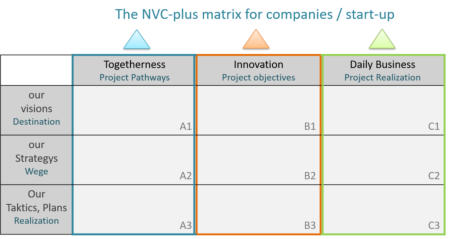


Organising projects with self-organised teams





























